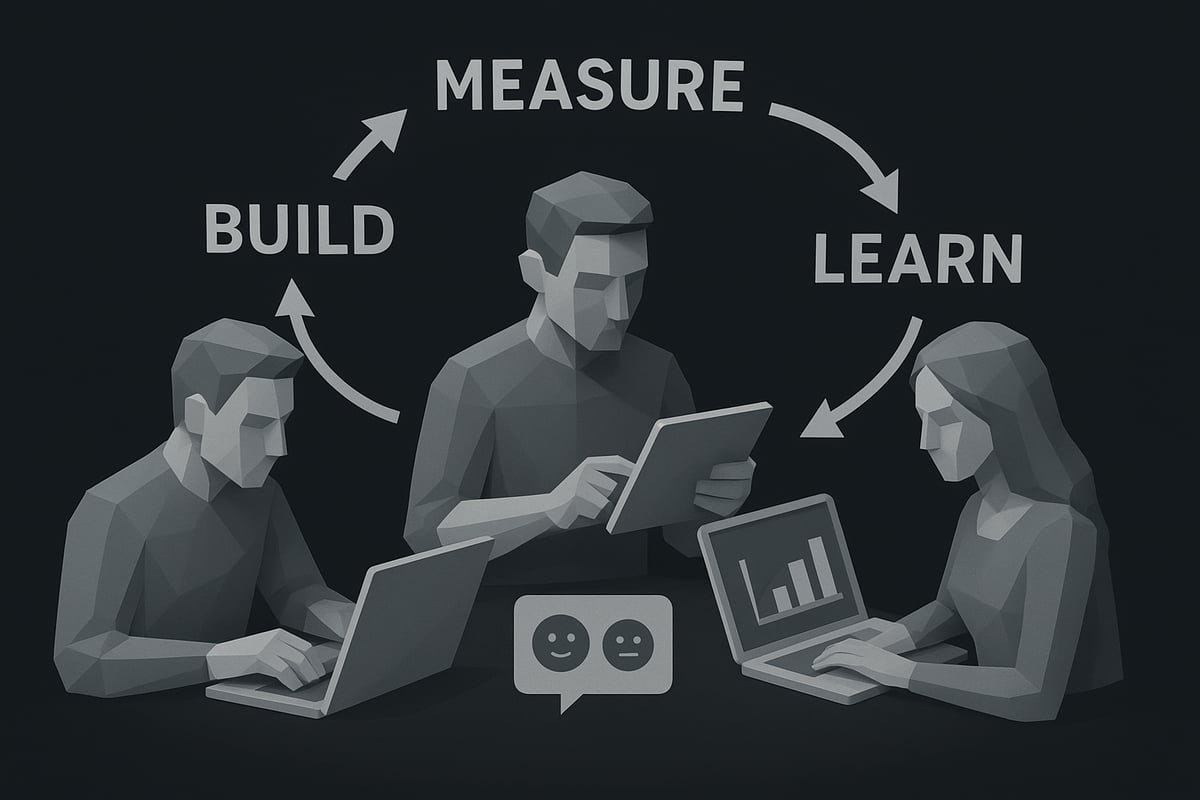Launching a business in 2025 brings both new opportunities and fierce competition. The barriers to entry are lower than ever, but standing out and thriving requires more than just a good idea.
This startup 101 guide is designed to equip you with a clear, step-by-step roadmap for building a successful startup in today’s rapidly evolving environment. From validating your idea and assembling the right team, to securing funding, developing your product, and scaling for sustainable growth, every stage will be covered with actionable insights.
Real-world examples and proven strategies will help you avoid common pitfalls and maximize your chances of success. Whether you are a first-time founder or looking to refine your approach, this guide will give you the knowledge and confidence to turn your vision into reality.
Step 1: Identifying and Validating Your Startup Idea
Launching a new business is thrilling, but every successful startup 101 journey begins with a validated idea. Before investing resources, founders must ensure their concept solves a real problem. This step acts as a filter, saving time and money while building a strong foundation for growth.

Understanding Market Needs and Gaps
Every startup 101 journey should start with deep market research. Identifying genuine customer pain points is the difference between solving a real need and launching a product that misses the mark. Founders can use surveys, one-on-one interviews, and competitor analysis to spot gaps that existing solutions overlook.
Consider the downfall of Juicero, which failed because there was little demand for its high-priced juicer. In contrast, Dropbox succeeded by addressing a widespread problem—easy file sharing. According to the Kauffman Foundation, nearly 90% of startups fail within their first three years. For more insight into why so many ventures falter, review these startup success and failure rates.
Looking ahead to 2025, trending sectors include AI, sustainability, remote work, and digital transformation. By aligning your startup 101 idea with these trends, you increase your chances of meeting emerging market demands.
Validation tools are essential. Platforms like Google Trends help you gauge search interest, while social listening reveals what customers are discussing online. Setting up MVP landing pages allows you to measure real user interest before building a full product.
Early feedback loops are vital. Engage with early adopters to refine your idea and pivot if needed. Their insights will help you reduce risk and guide your product in the right direction.
Crafting a Unique Value Proposition
Once you have validated your concept, the next startup 101 milestone is crafting a unique value proposition. This is your chance to stand out in a crowded market. Start by studying your competitors—what makes your solution different or better?
Define your startup’s “why.” Simon Sinek’s “Start with Why” framework encourages founders to articulate the deeper purpose behind their business. Why does your startup 101 exist, and why should customers care? This clarity drives both internal alignment and customer loyalty.
Outline your core benefits and outcomes. Be specific about how your product or service improves lives. Test your messaging with potential customers through interviews or A/B testing. Their reactions will reveal if your value proposition resonates.
Airbnb is a prime example. In its early days, the company built trust and community by offering local, authentic stays—a unique approach in the sharing economy. This clear value proposition helped them break through initial skepticism.
A compelling value proposition forms the bedrock of your startup 101 journey. It guides product development, marketing, and customer experience. By focusing on what truly sets you apart, you build a strong foundation for long-term growth and differentiation.
Step 2: Assembling the Right Team and Building Trust
Building a successful startup 101 company means more than just having a great idea. Your team is the engine that takes vision to reality. In today’s competitive landscape, the right mix of talent, trust, and collaboration can set your startup 101 apart from the rest.

The Power of Team Dynamics
The foundation of any startup 101 journey is a strong, diverse team. According to Harvard Business Review, 97% of leaders believe that collaboration is the key to successful outcomes. In startup 101, building a team with complementary skills ensures that every aspect of your business is covered.
Core roles to consider include:
- Technical (engineering, product development)
- Marketing (branding, growth)
- Operations (process, logistics)
- Finance (budgeting, funding)
A culture of transparency, inclusivity, and shared vision is essential. When team members feel valued and heard, creativity thrives. Slack’s founding team is a classic example: their commitment to user experience and open communication helped them pivot from a failed game to a billion-dollar platform.
Mutual respect and complementary skills prevent bottlenecks and foster resilience. Startup 101 teams often face setbacks, so strategies for conflict resolution and maintaining motivation—such as regular check-ins or celebrating small wins—are vital.
A practical approach is to define responsibilities clearly. For example, using a simple table can clarify who leads each area:
| Role | Responsibility | Example Team Member |
|---|---|---|
| Technical | Product Development | CTO |
| Marketing | Brand Awareness | Head of Marketing |
| Operations | Process Optimization | Operations Manager |
| Finance | Financial Planning | CFO |
A well-structured startup 101 team is your best asset for navigating challenges and seizing opportunities.
Establishing Trust and Accountability
Trust is the “mortar” that binds a startup 101 team together. Edelman’s research shows that 81% of consumers view trust as a dealbreaker. The same mindset applies internally: without trust, even the most skilled team will struggle.
Open communication is essential. Regular feedback sessions, transparent updates, and honest conversations help prevent misunderstandings. Setting clear expectations and measurable goals ensures everyone knows what success looks like.
Airbnb’s founders are a great example of trust in action. Their mutual confidence and transparent relationship with investors allowed them to weather early setbacks and keep their vision alive.
Remote work is now a reality for many startup 101 ventures. Utilizing tools like project management software and asynchronous communication platforms can maintain accountability and connection across locations.
Building trust also involves fostering a growth mindset for entrepreneurs. When your team embraces learning from failure and adapting quickly, you create a culture of resilience and innovation.
In summary, high-trust startup 101 teams consistently outperform in productivity and innovation. Prioritize trust, clarity, and accountability, and your team will be equipped to handle the challenges of the startup journey.
Step 3: Securing Funding and Financial Planning
Launching a business in today’s market means founders must navigate the complex world of startup 101 funding and financial planning. Securing the right resources and managing your finances smartly can make the difference between rapid growth and early failure. Let’s break down how to approach funding and financial strategy for your journey.

Exploring Funding Options in 2025
Every startup 101 journey begins with a critical decision: how will you fund your vision? In 2025, options are more diverse than ever. Bootstrapping, or self-funding, gives founders full control but can limit growth speed. External funding, such as angel investors, venture capital, crowdfunding, accelerators, and grants, provides resources but often requires giving up equity or meeting specific milestones.
Key funding sources to consider:
- Angel investors: Early believers who offer capital and mentorship.
- Venture capitalists: Firms seeking high-growth opportunities, often at later stages.
- Crowdfunding: Engages the public and builds validation.
- Accelerators and grants: Provide funding, support, and networks, often in exchange for equity or participation.
A compelling pitch deck is essential for startup 101 founders aiming to attract investment. Investors look for clear traction, a sizable market, a strong team, and a well-articulated vision. Dropbox, for example, leveraged a simple MVP and a strong pitch to gain entry into Y Combinator, which became a launchpad for mass adoption.
Understanding valuation, equity, and dilution is crucial. Many founders underestimate how giving away equity early can impact their long-term control. In reality, only about 0.05% of startups secure venture capital, while most rely on savings or angel investors. For a detailed look at global startup funding trends 2025, explore the latest data to inform your funding strategy.
The startup 101 landscape is shifting rapidly, with micro-investments and community funding gaining traction. Staying informed about these trends helps you choose the right path and avoid common funding pitfalls.
Mastering Startup Financials
Financial planning is a cornerstone of startup 101 success. Building a lean, realistic financial model means projecting revenue, tracking your burn rate, and understanding your runway. These figures help you determine how long your startup can operate before needing more capital.
Poor pricing strategies can quickly derail a promising venture. The MoviePass example shows how unsustainable pricing and lack of financial discipline led to collapse, despite strong initial growth. Avoid this mistake by validating your pricing with real customers and monitoring profitability from day one.
Set clear milestones for each funding round and operational phase. This keeps your team focused and signals progress to investors. Use modern tools like accounting software, dashboards, and automated reporting to stay on top of your numbers.
Here’s a quick table summarizing essential financial tools for startup 101 founders:
| Tool | Purpose | Example Brands |
|---|---|---|
| Accounting | Track expenses, revenue | QuickBooks, Xero |
| Dashboards | Visualize KPIs | ChartMogul, Baremetrics |
| Payment | Manage transactions | Stripe, PayPal |
Ultimately, financial discipline is not just about survival. It’s about scaling your startup 101 efficiently, making data-driven decisions, and building a foundation for lasting growth.
Step 4: Developing Your Minimum Viable Product (MVP) and Iterating
Building a successful startup 101 venture in today’s landscape hinges on how quickly and effectively you can bring your idea to life. The MVP, or minimum viable product, is the critical starting point that lets founders test, learn, and adapt before investing heavily. Here’s how to master this foundational step.

MVP Development Best Practices
The startup 101 approach to MVP development is rooted in the Lean Startup methodology, which prioritizes building only what’s necessary to test core assumptions. Instead of aiming for a perfect product, focus on solving the most pressing customer problem with the simplest solution possible.
Key MVP best practices include:
- Identify your core value proposition and build features that directly address it.
- Use rapid prototyping tools to speed up development.
- Launch with the minimum feature set, then measure user engagement closely.
- Collect qualitative feedback from early users through interviews and surveys.
A classic example comes from Dropbox, which validated demand for its service with a simple explainer video before writing complex code. This allowed the team to gauge real interest, saving time and resources.
Consider the Lean Startup cycle:
| Step | Purpose | Outcome |
|---|---|---|
| Build | Create a simple MVP | Gather data |
| Measure | Analyze user feedback | Learn quickly |
| Learn | Adjust based on insights | Iterate product |
Using this cycle, startup 101 founders can avoid overengineering and ensure each feature serves a validated need. Tools like MVP landing pages and early sign-up forms enable you to test demand before scaling. For a deeper dive into launching your first product, check out the Steps to Start an Online Business guide.
Iteration and Product-Market Fit
After launching your MVP, the real work begins. Iteration is the backbone of startup 101 success, helping founders refine their product based on real user data instead of assumptions.
Track analytics such as user engagement, retention, and feature adoption. Use these insights to identify what’s working and what needs improvement. For instance, Slack famously began as a gaming company but pivoted to team communication after noticing users responded more to their internal chat tool. This pivot was driven by data, not guesswork.
Set up multiple feedback channels, including in-app surveys, net promoter score (NPS) tools, and user interviews. These loops allow you to adapt quickly and adjust your roadmap in response to genuine demand.
Remember, achieving product-market fit is not a one-time event. It’s an ongoing process of testing, learning, and evolving. By embracing iterative development, startup 101 founders can reduce wasted resources and accelerate their path to sustainable growth. The most successful startups treat their MVP as the first step in a continuous journey of improvement.
Step 5: Go-to-Market Strategy and Customer Acquisition
Bringing your vision to market is a pivotal phase in the startup 101 journey. A well-executed go-to-market strategy ensures your product reaches the right people at the right time. This step is where planning, creativity, and data-driven execution combine to fuel growth and early momentum.
Crafting a Winning Launch Plan
The first step in your go-to-market journey is pinpointing your target customer segments. Knowing who will benefit most from your offering is crucial for any startup 101 strategy. Develop detailed buyer personas, including demographics, pain points, and motivations. This clarity helps tailor your messaging and product positioning.
Successful startups build anticipation before launch. Consider strategies like waitlists, limited beta invites, or exclusive previews to generate excitement. Early adopters are often your best advocates, so nurture this group with personalized outreach and incentives.
Take inspiration from Airbnb’s creative guerrilla marketing. In the early days, Airbnb founders tapped into existing communities, used unconventional tactics, and fostered trust through authentic storytelling. Their approach turned users into passionate brand ambassadors.
Selecting the right marketing channels is vital for 2025. Evaluate social media, influencer partnerships, content marketing, and strategic alliances. Each channel should align with where your audience spends time and how they prefer to engage.
To measure your launch success, track key metrics such as customer acquisition cost (CAC), conversion rates, and retention. These data points reveal which strategies are working and where to optimize. For a deeper dive into current trends and numbers, review the Key startup statistics 2025 to benchmark your progress and understand the evolving landscape.
Startup 101 success hinges on clear goals and agile adaptation. Use real-world feedback to refine your approach, ensuring your launch plan is both robust and responsive.
Scaling Customer Acquisition
With your initial momentum in place, scaling customer acquisition becomes the next focus. For startup 101 founders, growth hacking tactics are invaluable. Launch referral programs to encourage word-of-mouth, implement viral loops to amplify reach, and seek partnerships that open new distribution channels.
Data-driven decisions are essential. Monitor your marketing spend and ROI closely, using analytics tools to identify high-performing campaigns. Test and iterate your strategies to maximize efficiency and minimize wasted resources.
Trust is a cornerstone of sustainable growth. According to Edelman, 81% of consumers say trust influences their buying decisions. Communicate transparently, deliver consistent value, and address customer concerns promptly. This approach not only attracts new users but also strengthens retention.
Automating parts of your marketing and sales processes can free up valuable time. Consider tools for email automation, CRM management, and performance tracking. These solutions help maintain a personalized touch while scaling your outreach.
Remember, sustainable growth in startup 101 is about balance. Focus equally on acquisition, activation, and retention. By building trust, leveraging the right tools, and staying agile, your startup can achieve meaningful, lasting expansion.
Step 6: Building for Sustainable Growth and Avoiding Common Pitfalls
Building a thriving company goes beyond the launch. In this final chapter of our startup 101 guide, we focus on the strategies and mindsets that drive sustainable growth and help founders sidestep the most common obstacles. Let’s break down how to ensure your startup not only survives, but thrives in 2025 and beyond.
Establishing a Scalable Business Model
A scalable business model is the backbone of long-term success in any startup 101 journey. Choosing the right revenue streams is crucial. Popular models include SaaS subscriptions, digital products, and marketplaces. Each offers varying levels of predictability and growth potential.
| Model | Pros | Cons |
|---|---|---|
| SaaS | Recurring revenue, high margins | Requires ongoing support |
| Marketplace | Network effects, scalability | Harder to reach liquidity |
| Digital Goods | Low cost, scalable | Price competition |
Recurring revenue models, such as SaaS or memberships, enable predictable income and easier forecasting. For a detailed breakdown of these models, explore Recurring Revenue Models Explained.
Mapping your business using the Business Model Canvas helps clarify key activities, partners, and value propositions. This clarity is essential for startup 101 founders aiming to scale. Automation also plays a significant role. By automating customer support, sales, or onboarding, you free up resources to focus on growth.
Monitoring key metrics like Lifetime Value (LTV), Monthly Recurring Revenue (MRR), and churn ensures you stay on track. The right systems make scaling more manageable and sustainable, setting the stage for lasting impact.
Avoiding Common Startup Mistakes
Even the most promising ventures can falter if they ignore the fundamentals of startup 101. Lack of market research is a frequent downfall, as seen in Juicero’s expensive misstep. Failing to differentiate from competitors or ignoring customer feedback can quickly erode your value proposition.
Financial mismanagement is another common trap. Startups must monitor cash flow and avoid unsustainable pricing, as illustrated by MoviePass’s collapse. Neglecting team culture and wellbeing can also undermine growth, leading to high turnover and lost momentum.
To help minimize risk, consider the following checklist:
- Conduct thorough market research before launch.
- Regularly gather and act on customer feedback.
- Monitor competitors and continuously refine your unique value.
- Practice disciplined financial planning and review.
- Invest in team culture and open communication.
For more actionable insights and statistics on what drives and derails startup success, visit Startup success principles.
Startup 101 is not just about having a great idea, but about executing with discipline, awareness, and adaptability. Avoiding these pitfalls positions your company for sustainable growth.
Adapting to Trends and Innovation in 2025
The startup 101 landscape is rapidly transforming as new technologies and business practices emerge. Embracing AI and automation can streamline operations and unlock new markets. Remote work is enabling access to global talent, but it also requires new management skills and communication tools.
Sustainability and social impact are becoming key differentiators. Customers and investors increasingly favor startups that prioritize environmental responsibility and ethical practices. Staying agile is vital. Be prepared to pivot as markets shift, and use data-driven decision-making to guide your path.
Continuous learning is a cornerstone of startup 101. Attend industry events, join founder communities, and invest in ongoing education. Encourage your team to experiment with new tools and approaches. By fostering a culture of innovation, you ensure your startup remains resilient and competitive in 2025 and beyond.
Building for sustainable growth means embedding adaptability into your DNA. The startup 101 journey never truly ends, but those who evolve with the times are best positioned to lead.
Recommended Resources and Further Learning
Navigating the startup 101 journey requires more than just ambition. Access to proven resources and continuous learning can set successful founders apart from the rest. Whether you are refining your business plan or expanding your network, the right tools and knowledge are essential to thrive in 2025.
Must-Read Books and Tools for Startup Founders
Building a foundation in startup 101 means learning from the best. Here are some essential books and tools every founder should explore:
| Book/Tool | Focus Area |
|---|---|
| The Lean Startup (Eric Ries) | Iterative product development |
| Zero to One (Peter Thiel) | Innovation, new markets |
| Hooked (Nir Eyal) | Habit-forming products |
| The Hard Thing About Hard Things | Overcoming challenges |
| Start with Why (Simon Sinek) | Purpose-driven leadership |
| Business Model Generation | Designing business models |
| Mixpanel, Trello, Stripe Atlas | Analytics, productivity, setup |
For those at the idea stage, Writing a Business Plan is a practical guide to turning concepts into action. Using these resources, startup 101 founders can avoid common missteps and accelerate their learning curve.
Additional Learning Opportunities
Beyond books, the startup 101 landscape demands ongoing growth. Enroll in online courses tailored for founders or join leading accelerators to access mentorship and funding. Platforms like Y Combinator’s Startup School and Coursera offer flexible learning paths.
Connect with other founders through local meetups, global conferences, and online communities. Subscribe to newsletters and tune into industry podcasts to stay ahead of trends. Remember, the most successful startup 101 founders prioritize learning and stay adaptable in a changing world.
As you’ve discovered in this guide, launching a successful startup in 2025 is all about combining proven steps with your unique insights—from validating your idea to building a strong team and mastering sustainable growth. If you’re ready to put these strategies into action and want clear guidance on developing your brand, growing your audience, and creating digital products that work for you, I encourage you to Get Started. With expert resources and step by step support, you can confidently move from idea to execution and build a thriving one person business.